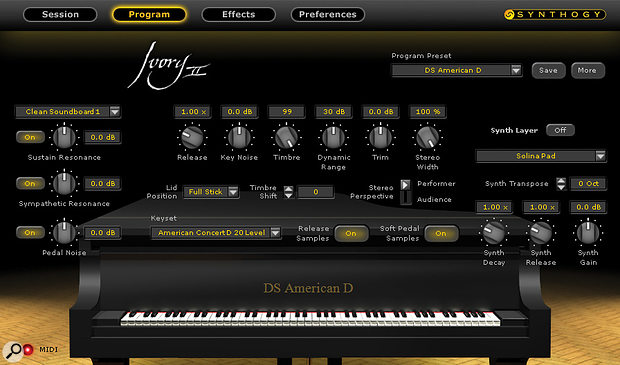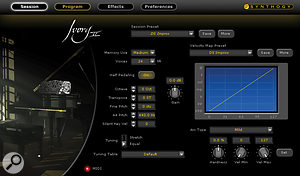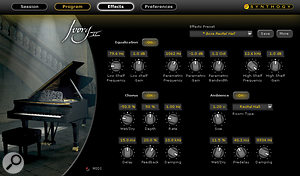 The 'Program' window contains the piano's most important controls, including global release time, pedal and key noise settings, stereo width and left-right flip, timbre (a subtle low-pass filter), dynamic range and sustain-pedal parameters.
The 'Program' window contains the piano's most important controls, including global release time, pedal and key noise settings, stereo width and left-right flip, timbre (a subtle low-pass filter), dynamic range and sustain-pedal parameters.
Synthogy capture one of legendary pianist Glenn Gould's favourite instruments.
What do Imogen Heap, Chick Corea, Mark Isham, RZA of The Wu-Tang Clan, Patrick Moraz, Michael Garson, Pete Townshend, Jordan Rudess and David Newman have in common? Select an answer from the following: 1. They are all avid supporters of Accrington Stanley Football Club. 2. Each appeared in an episode of TV's Storage Hunters. 3. All nine played guitar with The Who. Sadly, inspired though these guesses may be, they are completely wrong: the correct answer is that every one of these musicians enthusiastically endorses Ivory sampled pianos.
Ivory Pianos is the brainchild of Joe Ierardi, who cut his teeth designing hardware synths and digital pianos for Kurzweil in the 1980s, before setting up his own company, Synthogy, in 2002. Excited by the limitless memory of software samplers, Ierardi contacted former Kurzweil colleague and software designer George Taylor to explain his ideas for a new virtual piano. The enthusiasm proved contagious; according to Ierardi, "We basically decided to start a company and designed our first product all within that first 45-minute phone call!”
Released in 2004, Synthogy's first Ivory Grand Pianos package contained a German Steinway Model D, a Yamaha C7 and a Bösendorfer 290 Imperial, totalling around 40GB of unlooped samples. At the time, the product was Mac-only, but that limitation was long gone by the time Ivory II Grand Pianos hit the streets in 2010. This 77GB collection expanded the three pianos' eight velocity layers to 16 or 18 and introduced a number of new features, winning glowing praise from reviewers and players alike. Prior to releasing this collection, Synthogy added the 'Italian Grand' Fazioli piano and an Upright Pianos set (including honky-tonk and tack pianos) to their product line.
The latest addition to Synthogy's piano showroom, Ivory II American Concert D, sees the company's in-depth sampling techniques applied to a vintage, nine-foot 1951 New York Steinway Model D274 grand. The piano's distinguished history is reflected in its serial number, CD 121: long before the advent of the compact disc, Steinway & Sons applied the 'CD' tag to concert grands earmarked for the use of touring performers and recording artists, and number 121 was evidently a favourite of piano giants Glenn Gould and Rudolf Serkin. After much restoration work on the piano by technician Michel Pedneau, the samples were performed in the Françoys-Bernier Concert Hall in Quebec (also the recording location for the original Ivory German Steinway) by Synthogy's Joe Ierardi and recorded by engineer Mark Donahue of Soundmirror.
Parlo Americano
 Ivory pianos' 'Session' window hosts overall gain, tuning and velocity controls. The 'hardness' parameter determines the instrument's response to changes in key velocity, depicted in the blue Velocity Map graph: a zero setting produces a linear velocity-to-level response (as shown), and positive settings produce a quickly-rising slope (making the piano more sensitive to quiet notes than to louder ones), while negative settings have the opposite effect (ie. the piano becomes more sensitive to louder dynamics).
Ivory pianos' 'Session' window hosts overall gain, tuning and velocity controls. The 'hardness' parameter determines the instrument's response to changes in key velocity, depicted in the blue Velocity Map graph: a zero setting produces a linear velocity-to-level response (as shown), and positive settings produce a quickly-rising slope (making the piano more sensitive to quiet notes than to louder ones), while negative settings have the opposite effect (ie. the piano becomes more sensitive to louder dynamics).
I don't suppose I'll ever be able to afford to buy a real Steinway piano, but if I did, I'd be happy if it sounded like this one. The remarkable thing about American Concert D (ACD for short) is that it achieves clarity and transparency without sounding harsh or over-bright; softly played notes in broken chords and arpeggios maintain a distinct presence, rather than blurring together into an undifferentiated mush. The instrument's positive, well-defined attack enables precision of touch, yet its timbre still has plenty of warmth; this is a virtual piano you can play sensitively and lyrically, and its dynamic and inter-note transitions are silky-smooth. It could be argued that those who require a thunderous, banging piano sound would be better served by a Bösendorfer or Yamaha grand, but believe me, once you turn on its built-in EQ and add 6dB at 3k, this Steinway can bang with the best of them.
ACD has 20 velocity layers and occupies 45.1GB of disk space, making it the largest and most dynamically profound of all Ivory pianos. The full Monty uses over 1GB of RAM, but you can save memory by loading a scaled-down version with as few as four dynamic layers. You can also conserve RAM by turning off the Release samples, which replicate the quiet note-off decay and 'bump' of a damper returning to its string. This subtle enhancement is only clearly audible in an exposed solo setting, so you can deactivate it with little detrimental musical effect.
Naturalism being the name of the game, the samples are unlooped. Notes ring on to their full extent, some lasting 100 seconds or more. I felt a pang of sympathy for performer/producer Joe Ierardi having to sit in silence waiting for each string to stop sounding; you'd need the patience of a saint to do that 30 or 40 times per note over an 88-key range!
After enjoying myself playing ACD for an hour or so, I was amazed to find that I'd accidentally left my soundcard latency set to 64 samples. Playing an intensively-sampled instrument on my PC with such a low setting would normally invite all manner of audio horrors, but the efficient design of Ivory II's sound engine rendered my sustain-pedal-laden extravaganzas perfectly, with never a hint of a glitch or drop-out. From the player's point of view, the low latency adds to the piano's realism; you can almost 'feel' the notes under your fingertips.
 American Concert D has built-in reverb, chorus and three-band parametric EQ. The chorus effect imparts a mellow, wafty, pitch-spread warmth; increasing its depth produces a mildly honky-tonk effect that might come in useful if you were recording an ambient techno version of Chas & Dave's 'Gertcha'.
American Concert D has built-in reverb, chorus and three-band parametric EQ. The chorus effect imparts a mellow, wafty, pitch-spread warmth; increasing its depth produces a mildly honky-tonk effect that might come in useful if you were recording an ambient techno version of Chas & Dave's 'Gertcha'.
Pedal Pushers
When it comes to simulating the effect of the sustain pedal (something of a Holy Grail in piano sampling terms), Synthogy chose not to follow other companies' example of recording an additional set of pedal-down samples: instead, they use digital signal processing to simulate sustain pedal resonance, creating a pleasant and naturalistic sonic 'halo' around pedalled notes. ACD offers a choice of 11 resonance models, ranging from the subtle stereo ring of 'Clean Soundboard 1' to the super-echoey 'Extra Resonant 2', which sounds almost like a top-of-the range Lexicon reverb.
A more recent refinement designed by George Taylor is Sympathetic String Resonance, which apes real-life string behaviour by discreetly adding multiple overtones to held notes when a harmonically related new note is struck. These two facilities don't require any user programming skill: simply activate both on the GUI, and pedalled passages will automatically sound more realistic as they gain the characteristic, lush 'wash' effect of a real piano sustain pedal.
 Sustain-pedal emulation is governed by three parameters: Sustain Resonance controls the degree and type of soundboard resonance; Sympathetic Resonance simulates the natural phenomenon of held notes ringing in sympathy when a harmonically related new note is struck; and Pedal Noise introduces the ugly clunk made by a real sustain pedal.
Sustain-pedal emulation is governed by three parameters: Sustain Resonance controls the degree and type of soundboard resonance; Sympathetic Resonance simulates the natural phenomenon of held notes ringing in sympathy when a harmonically related new note is struck; and Pedal Noise introduces the ugly clunk made by a real sustain pedal.
Half-pedalling is a topic that occasionally erupts in Internet forums. Ivory pianos support this technique, although activating it in real time requires a continuous-control damper pedal, rather than the regular type that simply switches sustain on and off. With this controller, you can adjust the amount of after-ring on pedalled notes to anything from a short decay to a conventional full-length sustain. Personally, I don't feel it's a big deal, but its presence should satisfy those who feel it's an essential performance aid.
ACD's 'soft pedal' (aka una corda) style is likely to be of greater practical use to most users: this soothing, subtly muted sonority sounds heavenly when you reduce the 'Key Noise' parameter to minimum and add a dash of the ethereal 'Curved Space' chorused reverb effect. The soft-pedal samples are loaded via an on-off button on the control panel, after which you have to send a MIDI CC67 command to activate them.
Conclusion
Some have opined that different makes of piano are particularly suited to certain music genres, and I'd certainly agree that Yamaha grands work well for pop. But the great thing about ACD is that you can use it for virtually any style of music; its classic, expensive-sounding timbre is almost universally adaptable, and will add production value to arrangements with very little user effort. Basically, you just load it (which takes about 10 seconds) and play!
Over the years, I've grown used to reviewing virtual instruments with annoying bugs, flaws and omissions. "We'll fix it in an upgrade” has become the industry mantra. With ACD, there's nothing to fix: the instrument works perfectly straight out of the box, and playing it feels very much like operating a sleek, well-designed, pro-quality hardware unit, which I guess is where Messrs Ierardi and Taylor came in.
In the year that marks the 160th anniversary of the founding of Steinway & Sons, it's nice to know that this superb instrument, once the exclusive preserve of piano gods, is now available to us mortals at an affordable price. If you're thinking of buying a virtual piano, you should seriously consider American Concert D, because, frankly, they don't come any better than this.
Alternatives
In a marketplace positively bristling with virtual pianos, meaningful cost evaluations can only be made by comparing like with like, so let's take a look at other sampled (as opposed to modelled) Steinway D grand pianos currently on sale as single instruments.
Galaxy Instruments' 11GB (5GB installed) Vintage D features a fine 1920 German specimen sampled at 13 dynamic levels; it has similar facilities to American Concert D and shares the slightly warmer tone of the Ivory II German Steinway. Although the product is eight years old (an eternity in the sample world), the specs of Sampletekk's Black Grand (11.7GB) Hamburg-made Steinway continue to impress: it incorporates three microphone positions and 16 velocity layers for both up and down pedal positions. Older still are PMI's 1923 Steinway Model D (aka 'The Old Lady') and Steinway D titles, but their relatively modest (by today's standards) attributes are balanced by their humble price tag. Though less deeply sampled, the more recent Native Instruments New York Concert Grand is also competitively priced.
Moving into the realm of posh multi-piano packages, EastWest's gigantic Quantum Leap Pianos (which offers multiple mic positions), Synthogy's Ivory II Grand Pianos (summarised earlier) and Galaxy Instruments' Galaxy II package (featuring the surround-ready Galaxy 5.1 grand) are all intensively-sampled, pro-quality libraries; Ultimate Sound Bank's Grand Piano Collection and Native Instruments' Classic Piano Collection are also worthy contenders. All these titles contain a Steinway Model D along with other makes of piano.
Past Ivory Reviews
You can read the SOS reviews of previous Ivory products at:
USA vs Germany
"Comparisons are odious”, so said English lawyer Sir John Fortescue in his famous work De Laudibus Legum Angliae. Since Sir John has been dead for 537 years and is therefore unlikely to object, I took the liberty of comparing American Concert D with the German Steinway D from the Ivory II Grand Pianos package, using the 18 velocity-layer version of both to ensure a level playing field.
It's said that no two Steinways are alike, and the fact that these two pianos were manufactured thousands of miles apart might suggest their tone would be radically different. In fact, they are more similar than you might expect, partly due to them having been recorded in the same hall by the same producer. The American Concert D made in Steinway's New York factory has a brighter, more open tone at lower dynamic levels; an identical quiet passage played on the Hamburg-made German grand sounded warmer and more enveloping — very nice for intimate jazz or solo work.
I liked the American piano's evenness of touch across its seven-octave range. Its upper register is crystal clear at all dynamics, enabling me to achieve high-end bite without having to modify my naturally light keyboard touch. While anxious to avoid racial stereotyping, the German model exhibits a more Wagnerian, Sturm und Drang, Götterdämmerung, Donner und Blitzen clang in its loud bass notes, and the sharper tone it manifests at loud dynamics would give it the edge in a rock setting. However for my taste, the clear, open, transparent and lyrical timbre of the American Concert D makes it a better all-round piano, although I'd be reluctant to delete the Ivory II German Steinway off my hard drive!
System Requirements
The hardware requirements of this powerful instrument are surprisingly light. Synthogy's recommended specs are a mere 2GB of RAM and a 2GHz CPU, but the piano will work fine with a minimum of 1.5GB of RAM and a 1.8GHz processor. Ivory runs both stand-alone and as a plug-in on any AU, RTAS or VST 2 host on all Mac operating systems from OS 10.5.8 (Leopard) onwards, and on Windows XP SP2 (32-bit), Vista (32- or 64-bit) and Windows 7 (32 or 64-bit).
You'll need a 7200RPM or SSD hard drive for the samples (which will fit comfortably into 50GB of disk space), and a DVD drive for installation. As is the case with all Ivory products, a USB iLok key (which you have to buy separately) is required, with authorisation done online.
A further word about Ivory's stand-alone mode: The stand-alone player application has two versions: Ivory Standalone (for Mac) and Ivory Cantabile (for Windows), both included with the library. Created by TopTen Software specifically for Synthogy, the Ivory Cantabile player includes basic audio and MIDI recording facilities. The latter is somewhat counter-intuitive, but creates usable MIDI files.
Pros
- A superior, great-sounding piano with a distinguished history.
- Clear, transparent yet lyrical tone and a precise, well-defined touch.
- Deep sampling and professional presentation.
- Surprisingly low latency.
Cons
- None.
Summary
Ivory virtual pianos maintain their excellent reputation with a great-sounding American Steinway Model 'D' grand from the early 1950s, a personal favourite of piano legend Glenn Gould. Boasting 20 velocity layers, the sampled version sounds fabulous, plays like a dream and works well for every style of music, with the possible exception of Hard House and Black Metal.
information
Time+Space +44 (0)1837 55200.
